check engine light MERCEDES-BENZ R-CLASS FAMILY TOURER 2013 Owners Manual
[x] Cancel search | Manufacturer: MERCEDES-BENZ, Model Year: 2013, Model line: R-CLASS FAMILY TOURER, Model: MERCEDES-BENZ R-CLASS FAMILY TOURER 2013Pages: 364, PDF Size: 28.68 MB
Page 8 of 364
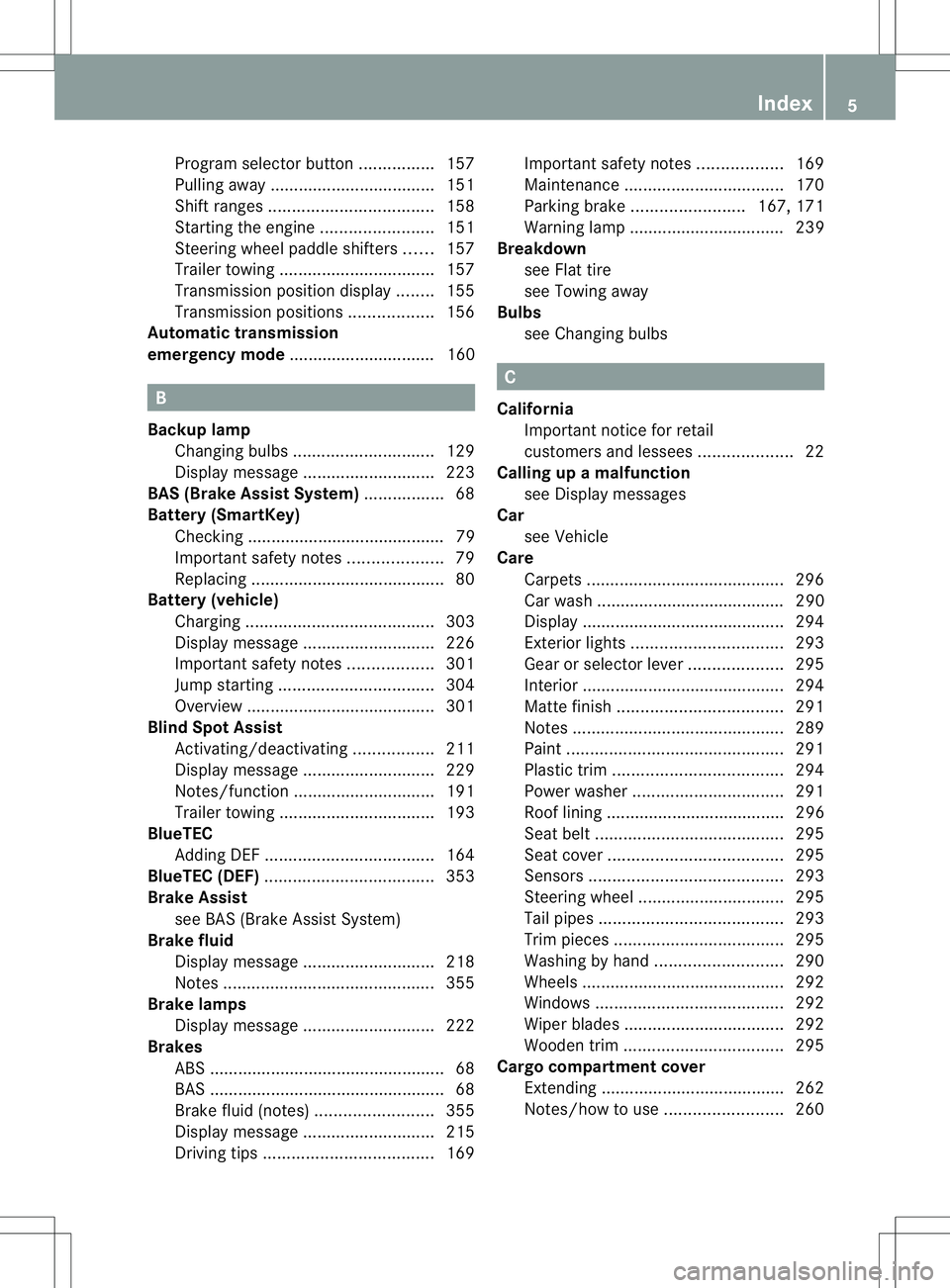
Program selector button
................157
Pulling away ................................... 151
Shift range s................................... 158
Starting the engine ........................151
Steering wheel paddle shifters ......157
Trailer towing ................................. 157
Transmissio nposition display ........155
Transmission positions ..................156
Automatic transmission
emergency mode ............................... 160 B
Backup lamp Changing bulbs .............................. 129
Display message ............................ 223
BAS (Brake Assist System) .................68
Battery (SmartKey) Checking .......................................... 79
Important safety notes ....................79
Replacing ......................................... 80
Battery (vehicle)
Charging ........................................ 303
Display message ............................ 226
Important safety notes ..................301
Jump starting ................................. 304
Overview ........................................ 301
Blin dSpot Assist
Activating/deactivating .................211
Display message ............................ 229
Notes/function .............................. 191
Trailer towing ................................. 193
BlueTEC
Adding DEF .................................... 164
BlueTEC (DEF) .................................... 353
Brake Assist see BAS (Brake Assist System)
Brake fluid
Display message ............................ 218
Notes ............................................. 355
Brake lamps
Display message ............................ 222
Brakes
ABS .................................................. 68
BAS .................................................. 68
Brake fluid (notes) .........................355
Display message ............................ 215
Driving tips .................................... 169Important safety notes
..................169
Maintenance .................................. 170
Parking brake ........................ 167, 171
Warning lamp ................................. 239
Breakdown
see Flat tire
see Towing away
Bulbs
see Changing bulbs C
California Important notice for retail
customers and lessees ....................22
Calling up a malfunction
see Display messages
Car
see Vehicle
Care
Carpets .......................................... 296
Car wash ........................................ 290
Display ........................................... 294
Exterior lights ................................ 293
Gea rors electo rlever .................... 295
Interior ........................................... 294
Matte finish ................................... 291
Notes ............................................. 289
Paint .............................................. 291
Plastic trim .................................... 294
Power washer ................................ 291
Roof lining ...................................... 296
Seat bel t........................................ 295
Seat cover ..................................... 295
Sensors ......................................... 293
Steering wheel ............................... 295
Tai lpipes ....................................... 293
Trim pieces .................................... 295
Washing by hand ........................... 290
Wheels ........................................... 292
Windows ........................................ 292
Wiper blades .................................. 292
Wooden trim .................................. 295
Cargo compartment cover
Extending ...................................... .262
Notes/ho wtouse......................... 260 Index
5
Page 10 of 364
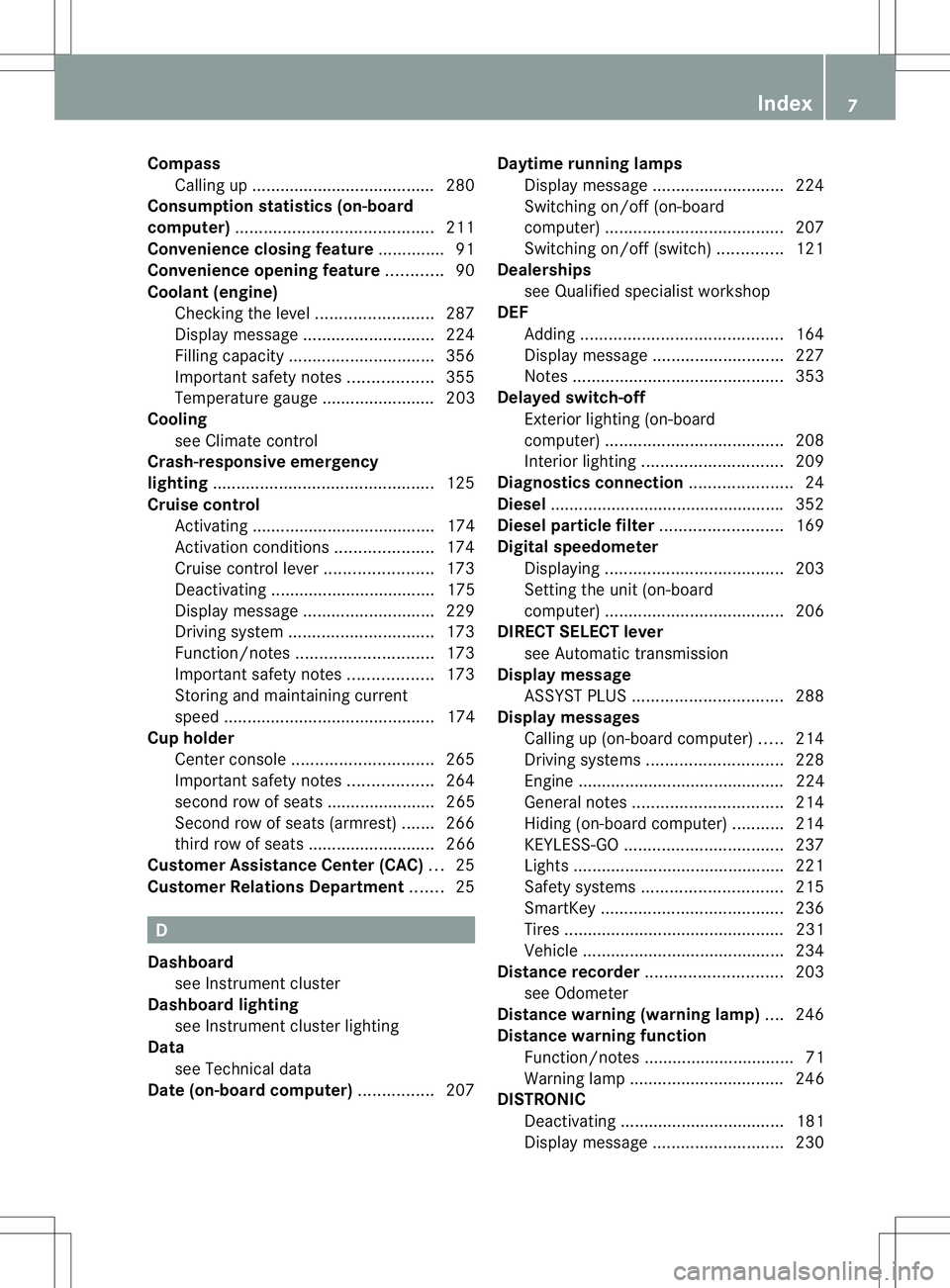
Compass
Calling up ...................................... .280
Consumption statistics (on-board
computer) .......................................... 211
Convenience closing feature ..............91
Convenience opening feature ............90
Coolan t(engine)
Checkin gthe level ......................... 287
Display message ............................ 224
Filling capacity ............................... 356
Important safety notes ..................355
Temperature gauge ........................ 203
Cooling
see Climate control
Crash-responsive emergency
lighting ............................................... 125
Cruise control Activating ....................................... 174
Activatio ncondition s..................... 174
Cruise control lever. ......................173
Deactivating ................................... 175
Display message ............................ 229
Driving system ............................... 173
Function/notes ............................. 173
Important safety notes ..................173
Storing and maintaining current
spee d............................................. 174
Cu p holder
Center console .............................. 265
Important safety notes ..................264
second row of seats ....................... 265
Second row of seats (armrest) .......266
third row of seats ........................... 266
Customer Assistance Center (CAC) ...25
Customer Relations Department .......25 D
Dashboard see Instrument cluster
Dashboard lighting
see Instrument cluster lighting
Data
see Technical data
Date (on-board computer) ................207Daytime running lamps
Display message ............................ 224
Switching on/off (on-board
computer) ...................................... 207
Switching on/off (switch) ..............121
Dealerships
see Qualified specialist workshop
DEF
Adding ........................................... 164
Display message ............................ 227
Notes ............................................. 353
Delaye dswitch-off
Exterio rlighting (on-board
computer )...................................... 208
Interior lighting .............................. 209
Diagnostics connection ......................24
Diesel ................................................. .352
Diesel particle filter ..........................169
Digital speedometer Displaying ...................................... 203
Setting the unit (on-board
computer) ...................................... 206
DIRECT SELECTl ever
see Automatic transmission
Displa ymessage
ASSYS TPLUS ................................ 288
Display messages
Calling up (on-board computer) .....214
Driving systems ............................. 228
Engine ............................................ 224
General notes ................................ 214
Hiding (on-board computer) ...........214
KEYLESS-GO .................................. 237
Lights ............................................ .221
Safety systems .............................. 215
SmartKey ....................................... 236
Tires ............................................... 231
Vehicle .......................................... .234
Distance recorder ............................. 203
see Odometer
Distance warning (warning lamp) ....246
Distance warning function Function/notes ................................ 71
Warning lamp ................................. 246
DISTRONIC
Deactivating ................................... 181
Display message ............................ 230 Index
7
Page 12 of 364
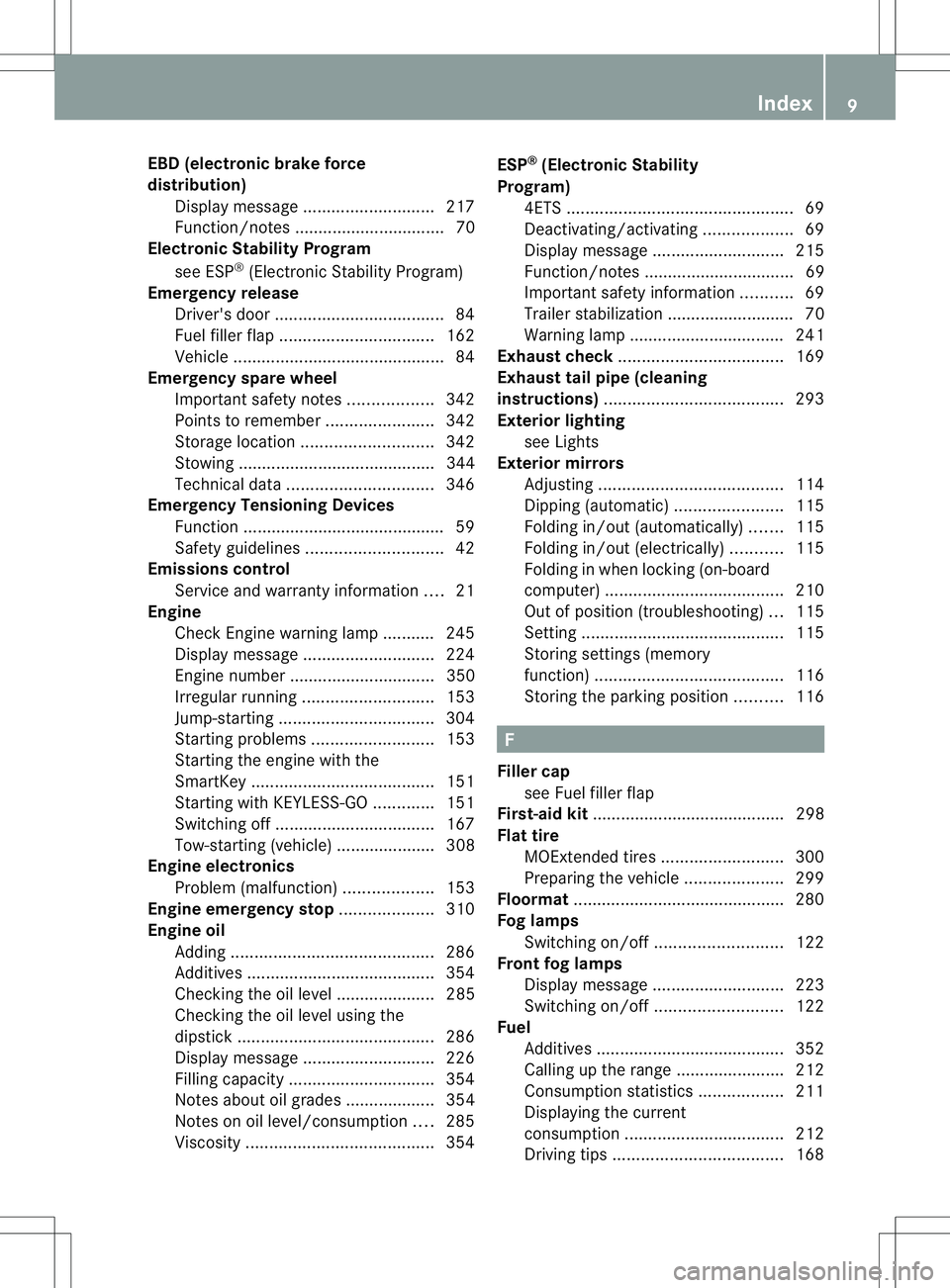
EBD (electronic brake force
distribution)
Display message ............................ 217
Function/notes ................................ 70
Electronic Stability Program
see ESP ®
(Electroni cStability Program)
Emergenc yrelease
Driver's door .................................... 84
Fuel filler fla p................................. 162
Vehicle ............................................. 84
Emergency spare wheel
Important safety notes ..................342
Points to remember .......................342
Storage location ............................ 342
Stowing .......................................... 344
Technical data ............................... 346
Emergency Tensioning Devices
Function .......................................... .59
Safety guidelines. ............................ 42
Emissions control
Service and warranty information ....21
Engine
Check Engine warning lamp ........... 245
Display message ............................ 224
Engine number ............................... 350
Irregularr unning............................ 153
Jump-starting ................................. 304
Starting problems ..........................153
Starting the engine with the
SmartKey ....................................... 151
Starting with KEYLESS-GO .............151
Switching off .................................. 167
Tow-starting (vehicle) ..................... 308
Engine electronics
Problem (malfunction) ...................153
Engine emergency stop ....................310
Engine oil Adding ........................................... 286
Additives ........................................ 354
Checking the oil level ..................... 285
Checking the oil level using the
dipstick .......................................... 286
Display message ............................ 226
Filling capacity ............................... 354
Notes about oil grades ................... 354
Notes on oil level/consumption ....285
Viscosity ........................................ 354ESP
®
(Electronic Stability
Program) 4ETS ................................................ 69
Deactivating/activating ...................69
Display message ............................ 215
Function/notes ................................ 69
Important safety information ...........69
Trailer stabilization ........................... 70
Warning lamp ................................. 241
Exhaus tcheck ................................... 169
Exhaus ttail pipe (cleaning
instructions) ...................................... 293
Exterior lighting see Lights
Exterior mirrors
Adjusting ....................................... 114
Dipping (automatic) .......................115
Folding in/out( automatically).......115
Folding in/out( electrically)...........115
Folding in whenl ocking (on-board
computer) ...................................... 210
Out of position (troubleshooting) ...115
Setting ........................................... 115
Storing settings (memory
function) ........................................ 116
Storing the parking position ..........116 F
Fille rcap
see Fuel filler flap
First-aid kit ......................................... 298
Flat tire MOExtended tires ..........................300
Preparing the vehicle .....................299
Floormat ............................................ .280
Fog lamps Switching on/off ........................... 122
Front fog lamps
Display message ............................ 223
Switching on/off ........................... 122
Fuel
Additives ........................................ 352
Calling up the range .......................212
Consumption statistics ..................211
Displaying the current
consumption .................................. 212
Driving tips .................................... 168 Index
9
Page 35 of 364
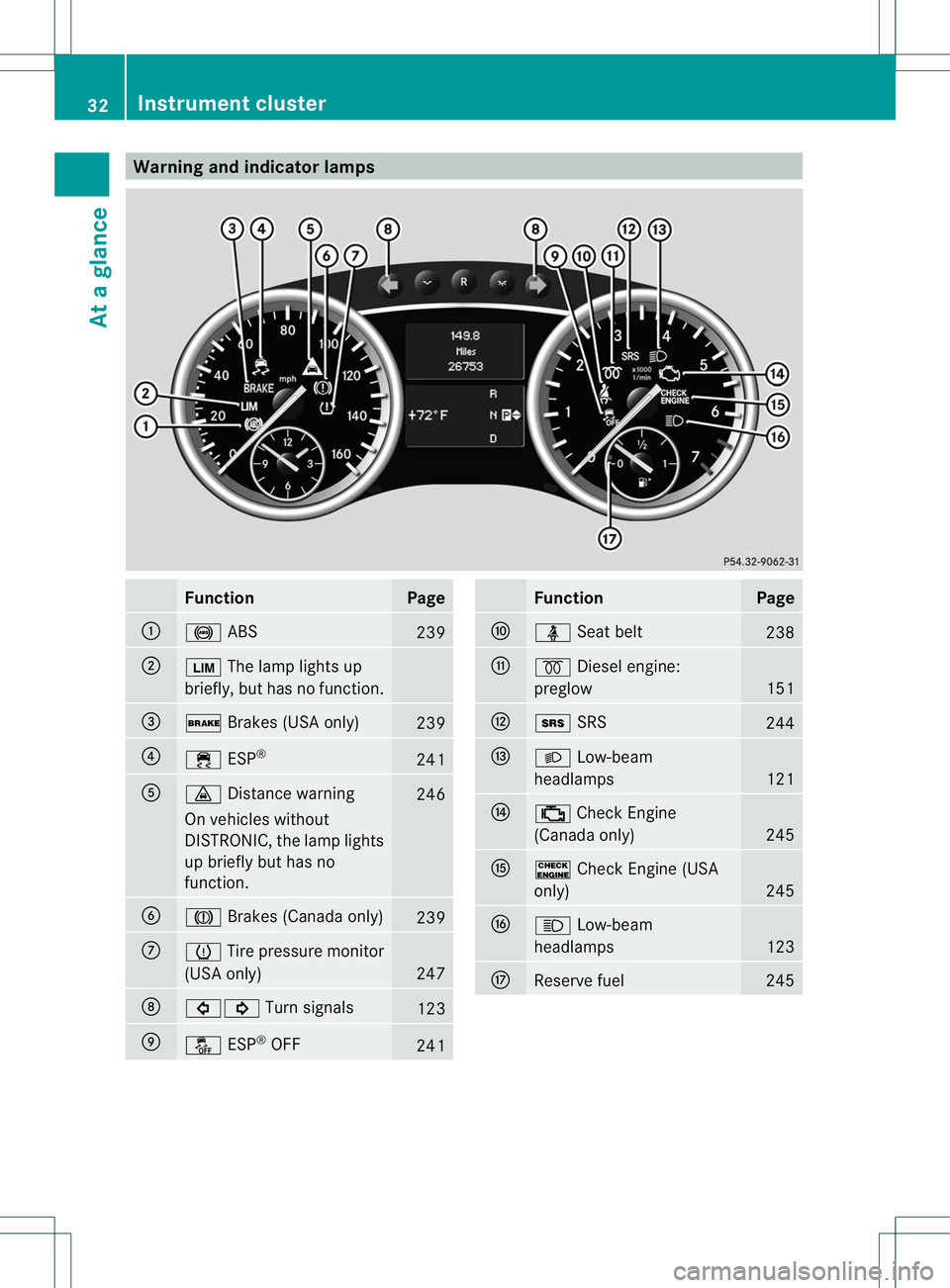
Warning and indicator lamps
Function Page
:
!
ABS 239
;
È
The lamp lights up
briefly, but has no function. =
$
Brakes (USA only) 239
?
÷
ESP® 241
A
·
Distance warning 246
On vehicles without
DISTRONIC, the lamp lights
up briefly but has no
function.
B
J
Brakes (Canada only) 239
C
h
Tire pressure monitor
(USA only) 247
D
#!
Turn signals 123
E
å
ESP®
OFF 241 Function Page
F
ü
Seat belt 238
G
%
Diesel engine:
preglow 151
H
+
SRS 244
I
L
Low-beam
headlamps 121
J
;
Check Engine
(Canada only) 245
K
!
Check Engine (USA
only) 245
L
K
Low-beam
headlamps 123
M
Reserve fuel 24532
Instrument clusterAt a glance
Page 44 of 364
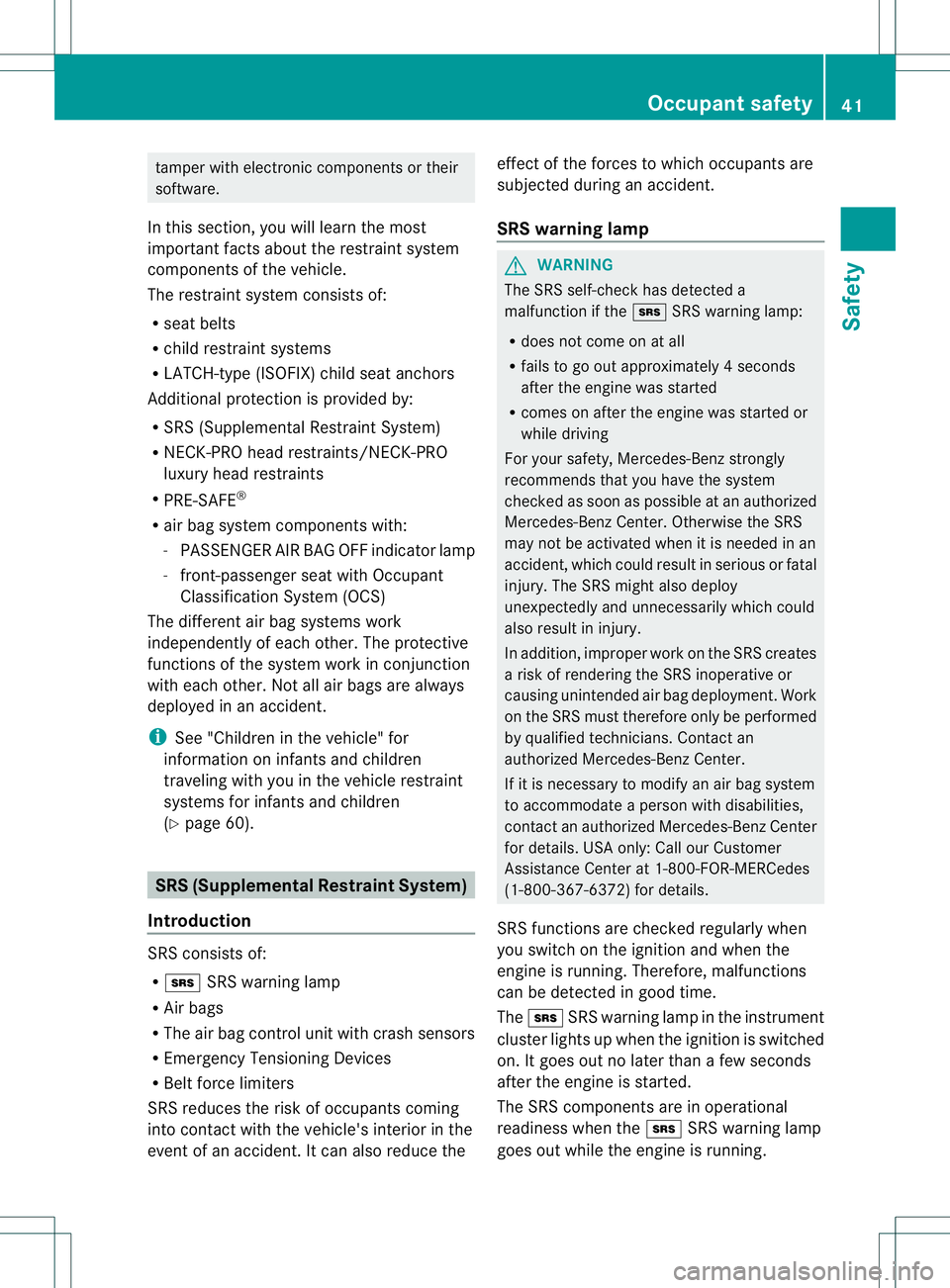
tamper with electronic components or their
software.
In this section, you will lear nthe most
important facts about the restraint system
components of the vehicle.
The restraint system consists of:
R seat belts
R child restraint systems
R LATCH-type (ISOFIX) child seat anchors
Additional protection is provided by:
R SRS (Supplemental Restraint System)
R NECK-PRO head restraints/NECK-PRO
luxury head restraints
R PRE-SAFE ®
R air bag system components with:
-PASSENGER AIR BAG OFF indicator lamp
- front-passenger seat with Occupant
Classification System (OCS)
The different air bag systems work
independently of each other. The protective
functions of the system work in conjunction
with each other. Not all air bags are always
deployed in an accident.
i See "Children in the vehicle" for
information on infants and children
traveling with you in the vehicle restraint
systems for infants and children
(Y page 60). SRS (Supplemental Restraint System)
Introduction SRS consists of:
R
+ SRS warning lamp
R Air bags
R The air bag control unit with crash sensors
R Emergency Tensioning Devices
R Belt force limiters
SRS reduces the risk of occupants coming
into contact with the vehicle's interior in the
event of an accident. It can also reduce the effect of the forces to which occupants are
subjected during an accident.
SRS warning lamp G
WARNING
The SRS self-check has detected a
malfunction if the +SRS warning lamp:
R does not come on at all
R fails to go out approximately 4seconds
after the engine was started
R comes on after the engine was started or
while driving
For your safety, Mercedes-Benz strongly
recommends that you have the system
checked as soon as possible at an authorized
Mercedes-Benz Center .Otherwise the SRS
may not be activated when it is needed in an
accident, which could resul tinserious or fatal
injury. The SRS might also deploy
unexpectedly and unnecessarily which could
also result in injury.
In addition, improper work on the SRS creates
a risk of rendering the SRS inoperative or
causing unintended air bag deployment. Work
on the SRS must therefore only be performed
by qualified technicians. Contac tan
authorized Mercedes-Ben zCenter.
If it is necessary to modify an air bag system
to accommodate a person with disabilities,
contact an authorized Mercedes-Benz Center
for details. USA only: Call our Customer
Assistance Center at 1-800-FOR-MERCedes
(1-800-367-6372) for details.
SRS functions are checked regularly when
you switch on the ignition and when the
engine is running. Therefore, malfunctions
can be detected in good time.
The + SRS warning lamp in the instrument
cluster lights up when the ignition is switched
on. It goes out no later than a few seconds
after the engine is started.
The SRS components are in operational
readiness when the +SRS warning lamp
goes out while the engine is running. Occupant safety
41Safety Z
Page 71 of 364
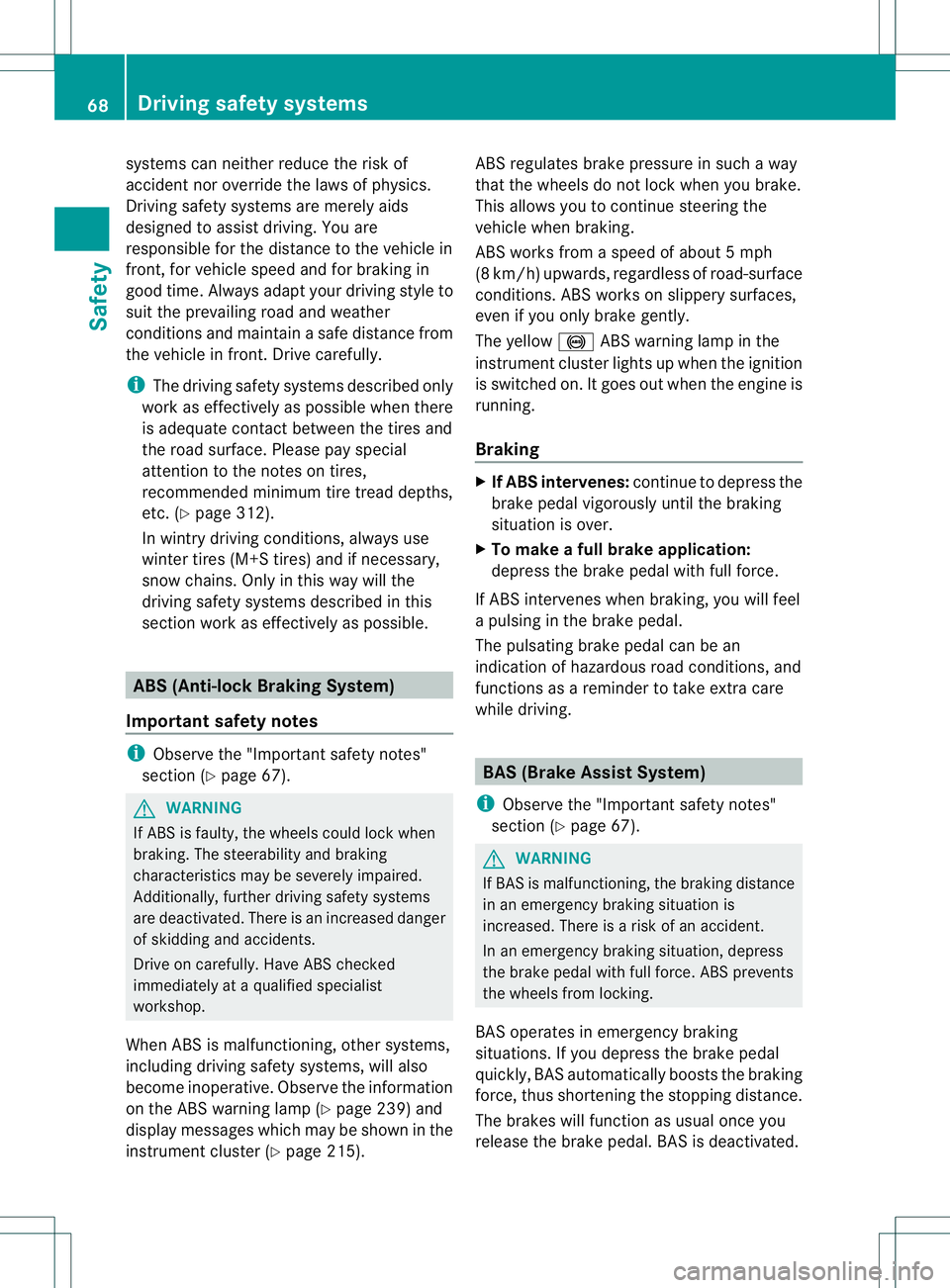
systems can neither reduce the risk of
accident nor override the laws of physics.
Driving safety systems are merely aids
designed to assist driving. You are
responsible for the distance to the vehicle in
front, for vehicle speed and for braking in
good time. Always adapty
our driving style to
suit the prevailing road and weather
conditions and maintain asafe distance from
the vehicle in front. Drive carefully.
i The driving safety systems described only
work as effectively as possible when there
is adequate contact between the tires and
the road surface. Please pay special
attention to the note son tires,
recommended minimu mtire tread depths,
etc. (Y page 312).
In wintry driving conditions, always use
winter tires (M+S tires) and if necessary,
snow chains. Only in this way will the
driving safety systems described in this
section work as effectively as possible. ABS (Anti-lock Braking System)
Important safety notes i
Observe the "Importan tsafety notes"
sectio n(Ypage 67). G
WARNING
If ABSi s faulty, the wheels could lock when
braking. The steerability and braking
characteristics may be severely impaired.
Additionally, further driving safety systems
are deactivated. There is an increased danger
of skidding and accidents.
Drive on carefully. Have ABS checked
immediately at a qualified specialist
workshop.
When ABS is malfunctioning, other systems,
including driving safety systems, will also
become inoperative. Observe the information
on the ABS warning lamp (Y page 239) and
display messages which may be shown in the
instrument cluster (Y page 215). ABS regulates brake pressure in such a way
that the wheels do not lock when you brake.
This allows you to continue steering the
vehicle when braking.
ABS works from a speed of about 5 mph
(8 km/h) upwards, regardless of road-surface
conditions. ABS works on slippery surfaces,
even if you only brake gently.
The yellow
!ABS warning lamp in the
instrument cluster lights up when the ignition
is switched on. It goes out when the engine is
running.
Braking X
If ABS intervenes: continue to depress the
brake pedal vigorously until the braking
situation is over.
X To make a full brake application:
depress the brake pedal with full force.
If ABS intervenes when braking, you will feel
a pulsing in the brake pedal.
The pulsating brake pedal can be an
indication of hazardous road conditions, and
functions as a reminder to take extra care
while driving. BAS (Brake AssistS
ystem)
i Observe the "Important safety notes"
section (Y page 67). G
WARNING
If BAS is malfunctioning, the braking distance
in an emergency braking situation is
increased. There is a risk of an accident.
In an emergency braking situation, depress
the brake pedal with full force. ABS prevents
the wheels from locking.
BAS operates in emergency braking
situations. If you depress the brake pedal
quickly, BAS automatically boosts the braking
force, thus shortening the stopping distance.
The brakes will function as usual once you
release the brake pedal. BAS is deactivated. 68
Driving safety systemsSafety
Page 72 of 364
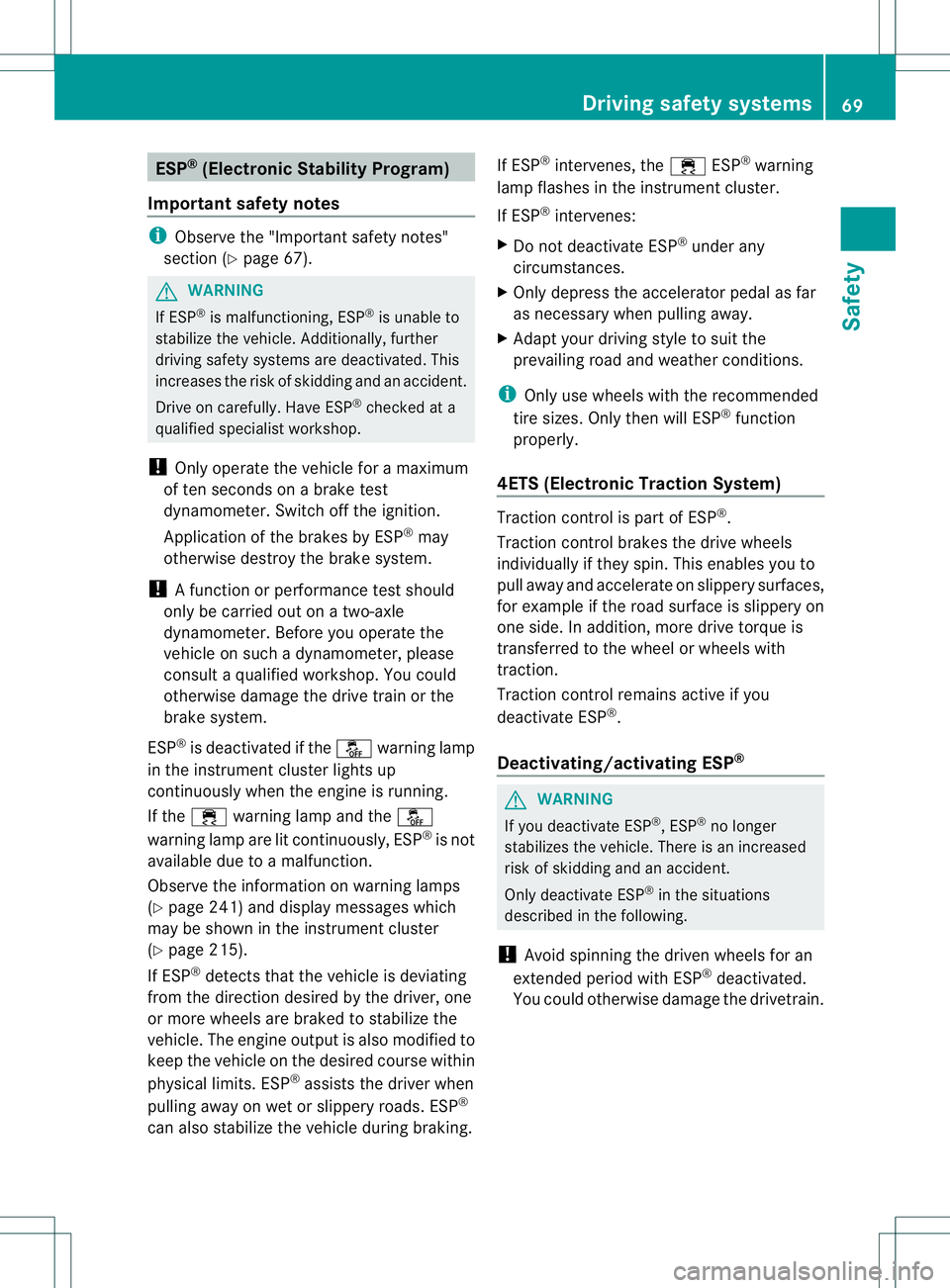
ESP
®
(Electronic Stability Program)
Important safety notes i
Observe the "Important safety notes"
sectio n(Ypage 67). G
WARNING
If ESP ®
is malfunctioning, ESP ®
is unable to
stabilize the vehicle. Additionally, further
driving safety systems are deactivated. This
increases the risk of skidding and an accident.
Drive on carefully. Have ESP ®
checked at a
qualified specialist workshop.
! Only operate the vehicle for a maximum
of ten seconds on a brake test
dynamometer. Switch off the ignition.
Application of the brakes by ESP ®
may
otherwise destroy the brake system.
! A function or performance test should
only be carried out on atwo-axle
dynamometer. Before you operate the
vehicle on such a dynamometer, please
consult a qualified workshop .You could
otherwise damage the drive train or the
brake system.
ESP ®
is deactivated if the åwarning lamp
in the instrument cluster lights up
continuously when the engine is running.
If the ÷ warning lamp and the å
warning lamp are lit continuously, ESP ®
is not
available due to a malfunction.
Observe the information on warning lamps
(Y page 241) and display messages which
may be shown in the instrument cluster
(Y page 215).
If ESP ®
detects that the vehicle is deviating
from the direction desired by the driver, one
or more wheels are braked to stabilize the
vehicle. The engine output is also modified to
keep the vehicle on the desired course within
physical limits. ESP ®
assists the driver when
pulling away on wet or slippery roads. ESP ®
can also stabilize the vehicle during braking. If ESP
®
intervenes, the ÷ESP®
warning
lamp flashes in the instrument cluster.
If ESP ®
intervenes:
X Do not deactivate ESP ®
under any
circumstances.
X Only depress the accelerator pedal as far
as necessary when pulling away.
X Adapt your driving style to suit the
prevailing road and weather conditions.
i Only use wheels with the recommended
tire sizes. Only then will ESP ®
function
properly.
4ETS (Electronic Traction System) Traction control is part of ESP
®
.
Traction control brakes the drive wheels
individually if they spin. This enables you to
pull away and accelerate on slippery surfaces,
for example if the road surface is slippery on
one side. In addition, more drive torque is
transferred to the wheel or wheels with
traction.
Traction control remains active if you
deactivate ESP ®
.
Deactivating/activating ESP ® G
WARNING
If you deactivate ESP ®
, ESP ®
no longer
stabilizes the vehicle. There is an increased
risk of skidding and an accident.
Only deactivate ESP ®
in the situations
described in the following.
! Avoid spinning the driven wheels for an
extended period with ESP ®
deactivated.
You could otherwise damage the drivetrain. Driving safety systems
69Safety Z
Page 73 of 364
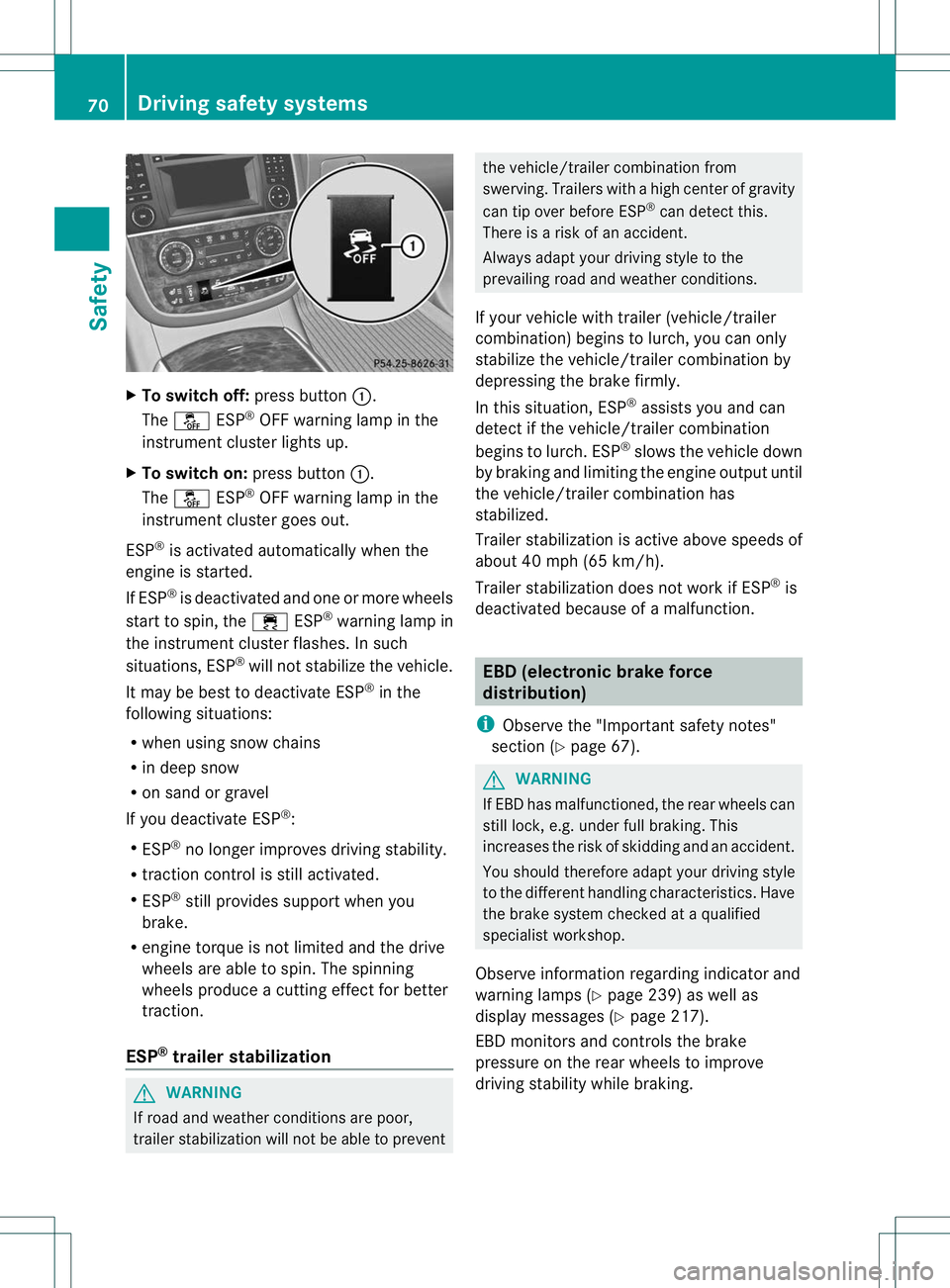
X
To switch off: press button:.
The å ESP®
OFF warning lamp in the
instrument cluster lights up.
X To switc hon:press button :.
The å ESP®
OFF warning lamp in the
instrument cluster goes out.
ESP ®
is activated automatically when the
engine is started.
If ESP ®
is deactivated and one or more wheels
start to spin, the ÷ESP®
warning lamp in
the instrument cluster flashes. In such
situations, ESP ®
will not stabilize the vehicle.
It may be best to deactivate ESP ®
in the
following situations:
R when using snow chains
R in deep snow
R on sand or gravel
If you deactivate ESP ®
:
R ESP ®
no longer improves driving stability.
R traction control is still activated.
R ESP ®
still provides support when you
brake.
R engine torque is not limited and the drive
wheels are able to spin. The spinning
wheels produce a cutting effec tfor better
traction.
ESP ®
trailer stabilization G
WARNING
If road and weather conditions are poor,
trailer stabilization will not be able to prevent the vehicle/trailer combination from
swerving. Trailers with a high center of gravity
can tip over before ESP
®
can detect this.
There is a risk of an accident.
Always adapt your driving style to the
prevailing road and weather conditions.
If your vehicle with trailer (vehicle/trailer
combination) begins to lurch, you can only
stabilize the vehicle/trailer combination by
depressing the brake firmly.
In this situation, ESP ®
assists you and can
detect if the vehicle/trailer combination
begins to lurch. ESP ®
slows the vehicle down
by braking and limiting the engine output until
the vehicle/trailer combination has
stabilized.
Trailer stabilization is active above speeds of
about 40 mph (65 km/h).
Trailer stabilization does not work if ESP ®
is
deactivated because of a malfunction. EBD (electronic brake force
distribution)
i Observe the "Important safety notes"
section (Y page 67). G
WARNING
If EBD has malfunctioned, the rear wheels can
still lock, e.g. under full braking. This
increases the risk of skidding and an accident.
You should therefore adapt your driving style
to the different handling characteristics. Have
the brake system checked at a qualified
specialist workshop.
Observe information regarding indicator and
warning lamps (Y page 239) as well as
display messages (Y page 217).
EBD monitors and controls the brake
pressure on the rear wheels to improve
driving stability while braking. 70
Driving safety systemsSafety
Page 80 of 364
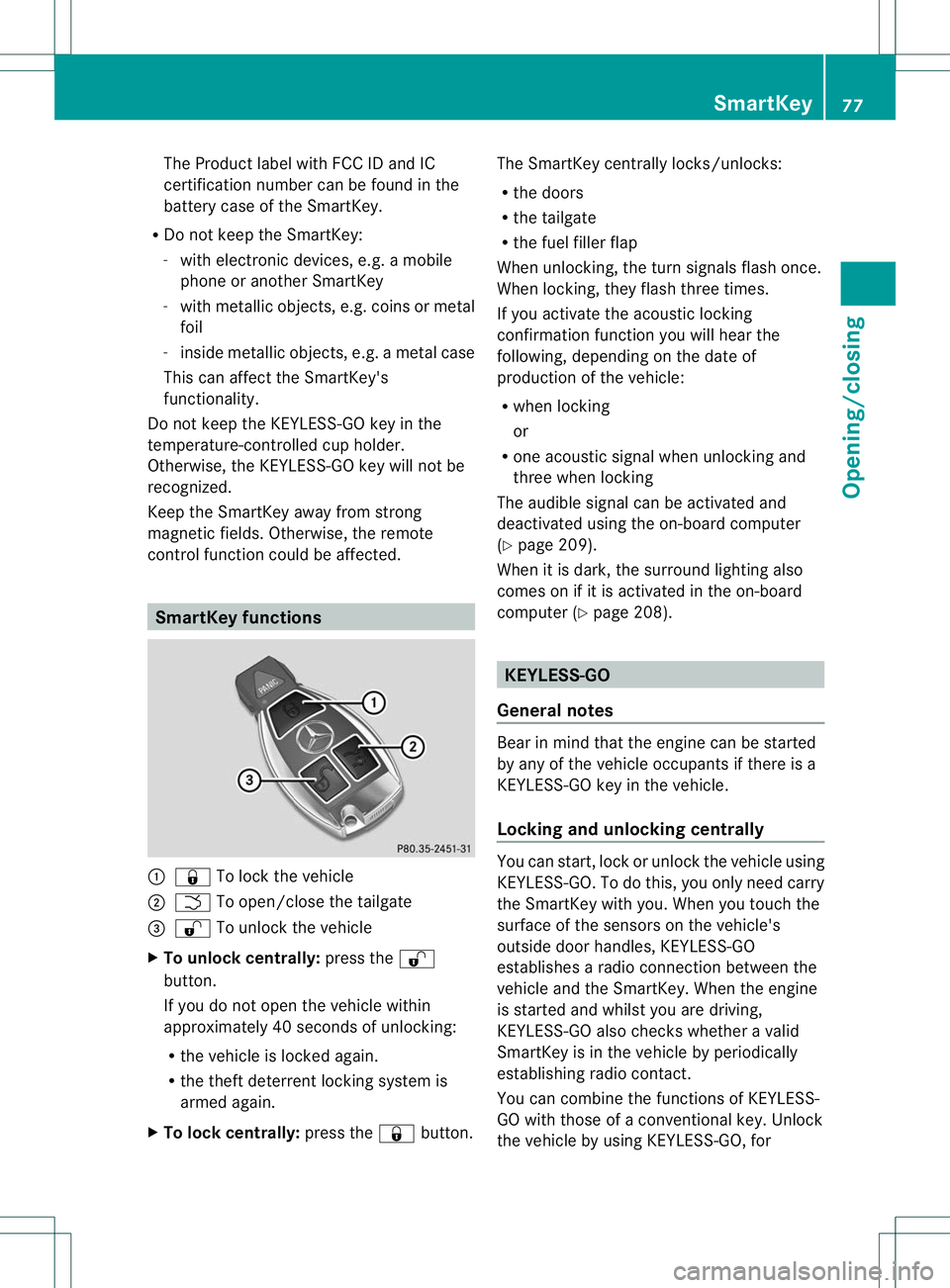
The Product label with FCC ID and IC
certification number can be found in the
battery case of the SmartKey.
R Do not keep the SmartKey:
-with electronic devices, e.g. a mobile
phone or another SmartKey
- with metallic objects, e.g. coins or metal
foil
- inside metallic objects, e.g. a metal case
This can affect the SmartKey's
functionality.
Do not keep the KEYLESS-GO key in the
temperature-controlled cup holder.
Otherwise, the KEYLESS-GO key will not be
recognized.
Keep the SmartKey away from strong
magnetic fields. Otherwise, the remote
control function could be affected. SmartKey functions
:
& To lock the vehicle
; F To open/close the tailgate
= % To unlock the vehicle
X To unlock centrally: press the%
button.
If you do not open the vehicle within
approximately 40 seconds of unlocking:
R the vehicle is locked again.
R the theft deterrent locking system is
armed again.
X To lock centrally: press the&button. The SmartKey centrally locks/unlocks:
R
the doors
R the tailgate
R the fuel filler flap
When unlocking, the turn signals flash once.
When locking, they flash three times.
If you activate the acoustic locking
confirmation function you will hear the
following, depending on the date of
production of the vehicle:
R when locking
or
R one acoustic signal when unlocking and
three when locking
The audible signal can be activated and
deactivated using the on-board computer
(Y page 209).
When it is dark, the surround lighting also
comes on if it is activated in the on-board
computer (Y page 208). KEYLESS-GO
General notes Bear in mind that the engine can be started
by any of the vehicle occupants if there is a
KEYLESS-GO key in the vehicle.
Locking and unlocking centrally
You can start, lock or unlock the vehicle using
KEYLESS-GO. To do this, you only need carry
the SmartKey with you. When you touch the
surface of the sensors on the vehicle's
outside door handles, KEYLESS-GO
establishes a radio connection between the
vehicle and the SmartKey. When the engine
is started and whilst you are driving,
KEYLESS-GO also check
swhether a valid
SmartKey is in the vehicle by periodically
establishing radio contact.
You can combine the functions of KEYLESS-
GO with those of a conventional key. Unlock
the vehicle by using KEYLESS-GO, for SmartKey
77Opening/closing Z
Page 85 of 364
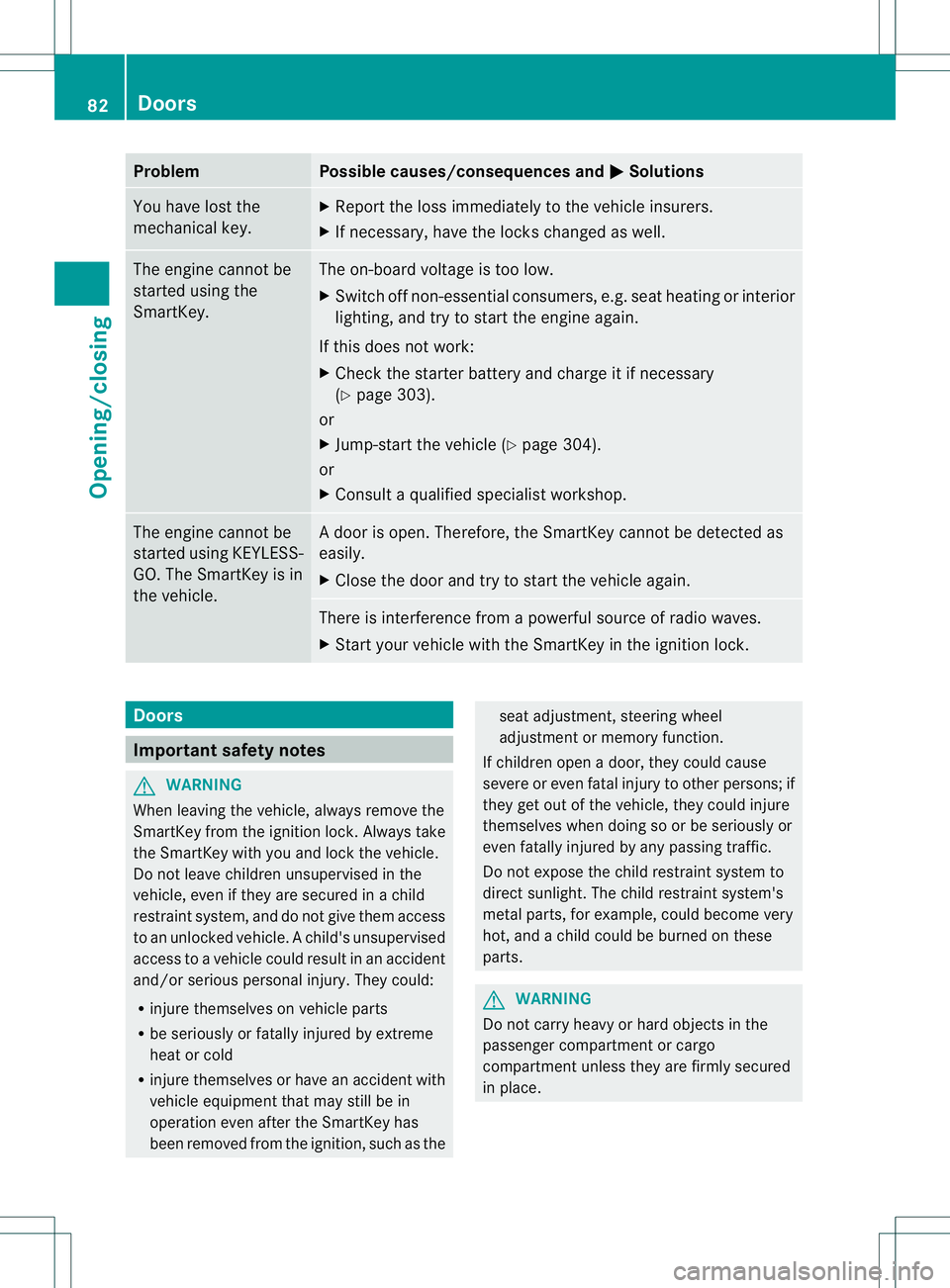
Problem Possible causes/consequences and
M Solutions
You have lost the
mechanical key. X
Report the loss immediately to the vehicle insurers.
X If necessary, have the locks changed as well. The engine cannot be
started using the
SmartKey. The on-board voltage is too low.
X
Switch off non-essential consumers, e.g. seat heating or interior
lighting, and try to start the engine again.
If this does not work:
X Check the starter battery and charge it if necessary
(Y page 303).
or
X Jump-start the vehicle (Y page 304).
or
X Consult a qualified specialist workshop. The engine cannot be
started using KEYLESS-
GO. The SmartKey is in
the vehicle. Ad
oor is open. Therefore, the SmartKey cannot be detected as
easily.
X Close the door and try to start the vehicle again. There is interference from a powerful source of radio waves.
X
Start your vehicle with the SmartKey in the ignition lock. Doors
Important safety notes
G
WARNING
When leaving the vehicle, always remove the
SmartKey from the ignition lock. Always take
the SmartKey with you and lock the vehicle.
Do not leave children unsupervised in the
vehicle, even if they are secured in a child
restraint system, and do not give them access
to an unlocked vehicle. Achild's unsupervised
access to a vehicle could result in an accident
and/or serious personal injury. They could:
R injure themselves on vehicle parts
R be seriously or fatally injured by extreme
heat or cold
R injure themselves or have an accident with
vehicle equipment that may still be in
operation even after the SmartKey has
been removed from the ignition, such as the seat adjustment, steering wheel
adjustment or memory function.
If children open a door, they could cause
severe or even fatal injury to other persons; if
they get out of the vehicle, they could injure
themselves when doing so or be seriously or
even fatally injured by any passing traffic.
Do not expose the child restraint system to
direct sunlight. The child restraint system's
metal parts, for example, could become very
hot, and a child could be burned on these
parts. G
WARNING
Do not carry heavy or hard objects in the
passenger compartment or cargo
compartmentu nless they are firmly secured
in place. 82
DoorsOpening/closing